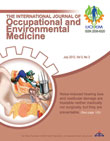فهرست مطالب

International Journal of Occupational and Environmental Medicine
Volume:3 Issue: 3, Jul 2012
- تاریخ انتشار: 1391/05/12
- تعداد عناوین: 8
-
-
Page 107BackgroundDespite the advances in medical therapy and technology, the prognosis of idiopathic pulmonary fibrosis (IPF) remains poor and the need for disease prevention based on identifying the risk factors becomes mandatory. Occupational and environmental exposures were studied in several countries and found to play important role in the disease development. However, in Egypt, a little attention has been paid to study the effect of these factors in the disease development.ObjectiveTo identify the occupational and environmental risk factors associated with the development of IPF in Egypt.MethodsA multicenter hospital-based case-control study was carried out in chest hospitals affiliated to three Egyptian cities—Cairo, Tanta and Mansoura. Subjects were 201 patients with confirmed IPF (cases) and 205 age-, sex- and residence-matched controls. Data on occupational and environmental factors were obtained from a questionnaire. Multiple logistic regression analysis was used to determine the independent risk factors of IPF in both sexes for single factors with adjustment for age, residence and smoking status.ResultsCompared with the controls, the risk of IPF in male workers was observed to increase significantly in chemical and petrochemical industries and carpentry and wood working (OR=2.56, 95% CI: 1.02–7.01), and with occupational exposures to wood dust and wood preservatives. Among female workers, a significant increase was observed in farming (OR=3.34, 95% CI: 1.17–10.12), raising birds and occupational exposures to animal feeds, products and dusts and pesticides. Risk of IPF decreased significantly in male workers and insignificantly among female workers in sales and clerical related activities. The environmental exposures to birds and cats were significantly associated with elevated risk of IPF development in both sexes.ConclusionIn Egypt, farming, raising birds and wood working are important risk factors for the development of IPF.
-
Page 117BackgroundGasoline station workers are exposed to volatile organic compounds such as benzene, toluene, ethylbenzene and xylene (BTEX).ObjectivesTo determine the level of exposure to BTEX compounds among gasoline station workers and measure the roadside concentrations of these compounds in the inner and outer areas of Bangkok, Thailand.Methods49 workers at 6 gasoline stations in the inner and outer areas of Bangkok participated in this study. Samples of ambient air were collected from the area near gas pumps at each station and at the roadside in front of the gas stations by charcoal tubes. All samples were analyzed for BTEX compounds by gas chromatography-flame ionized detector (GC-FID).ResultsThe mean BTEX concentration in gas stations was slightly higher than that of the roadside; there was no significant difference in the concentration between inner and outer areas. The mean lifetime cancer risks for workers exposed to benzene and ethylbenzene for 30 years were estimated at 1.75×10–4 and 9.55×10–7. The estimated hazard quotients for BTEX compounds were 0.600, 0.008, 0.007 and 0.002, respectively. The most prevalent symptoms of workers were headache (61%), fatigue (29%) and throat irritation (11%), respectively. Exposure to benzene and toluene was significantly associated with fatigue (p<0.05).ConclusionExposure to BTEX compounds would increase the risk of cancer in gasoline station workers. Exposure to benzene and toluene may cause fatigue.
-
Page 126BackgroundAnthropometric kits are extensively used in workstation and product design projects, and with the advancement of technology, they have turned into highly complex and effective instruments. However, there are still many challenging problems in usability and reliability of application of these kits in real-world settings.ObjectivesTo identify the usability and accuracy issues with a conventional anthropometric caliper, and to propose measurable design features to enhance the functionality of the caliper.MethodsThe measurement process using a conventional anthropometric caliper was systematically analyzed through detailed hierarchical task analyses. Also, six qualified anthropometry specialists performed heuristic evaluations to gain valuable insights into major usability issues in relation to the existing body measurement devices. Based on the resulting concepts, a mock-up was developed and evaluated against the desired specifications.ResultsIncorrect positioning angle of the caliper, as well as applying various amounts of force by different investigators to push the caliper branches against body parts, appeared to be the main factors introducing inaccuracy to anthropometric data. Installing a spirit level on caliper, and also a pre-programmed microprocessor for real-time saving of the obtained data, facilitated the measurement process for both investigators and subjects.ConclusionAccuracy, followed by usability is the primary concern in designing anthropometric instruments. However, expectations would vary from one specialist to another. Therefore, trade-offs should be made when incorporating innovative features in novel designed body measurement kits.
-
Page 136BackgroundNoise can cause permanent or temporary hearing loss. High levels of noise may stimulate the vestibular system and thereby cause disturbances in the balancing mechanism.ObjectiveTo determine the effect of long-term exposure to occupational noise on the vestibular system.MethodsA dizziness questionnaire was administered to 20 factory workers who were exposed to occupational noise for more than 10 years. The results were compared with 2 control groups. The control group 1 consisted of 20 people who had similar physical activity during work but were not exposed to high level of noise. Control group 2 consisted of 20 students never exposed to hazardous noise.ResultsThere was significant difference between the experimental group and the 2 control groups in terms of frequency of vestibular symptoms. However, most of the symptoms were subtle in nature. Tinnitus was significantly (p<0.05) more frequent in the experimental group than the 2 control groups.ConclusionsLong-term exposure to noise may cause vestibular symptoms before clinically detectable hearing loss. The symptoms are subtle for which they are mostly neglected; the symptoms do not affect the functional ability of workers.
-
Page 145BackgroundNoise-induced hearing loss (NIHL) is one of the most common occupational illnesses. Most of the studies on NIHL were conducted at high noise levels that people are rarely exposed to but in industries. The function of the outer hair cells (OHCs) is impaired after exposure to industrial noise. Distortion product otoacoustic emissions (DPOAEs) are useful in examination of noise-induced level shifts.ObjectivesTo assess the function of OHCs by DPOAE temporary and permanent level shifts (TLSdp and PLSdp) in rabbits exposed to white noise at realistic levels typically found in industrial settings over a broad range of frequencies.Methods12 albino rabbits were divided into two groups: the experimental group rabbits which were exposed to 95 dB SPL white noise at 500–8000 Hz for 8 hrs/day for 5 consecutive days, and the control group rabbits with no exposure to noise. The function of OHCs was examined by DPOAE level (Ldp) in different occasions. The study groups were compared for DPOAE temporary and permanent level shifts (TLSdp and PLSdp) to assess the effect of noise on OHCs function.ResultsNoise-induced DPOAE levels (Ldp) were decreased up to 20.65 dB (on day 8) and 18.93 dB (on day 11) at 5888.50 Hz (p=0.081). TLSdp and PLSdp were significantly decreased up to 17.99 dB and 16.27 dB, respectively in the experimental group. The most and least Ldp were significantly different (p<0.05); they occurred at 5888.50 and 588.00 Hz, respectively. There were significant differences between temporary and permanent threshold shift at various frequencies (p<0.05). These differences were mainly related to 5888.50 Hz compared to other frequencies in each ear (p<0.05).ConclusionDPOAEs are an attractive tool for obtaining information about small temporary or permanent threshold shifts, even when the pure tone audiogram is normal.
-
Page 153
-
Page 155


